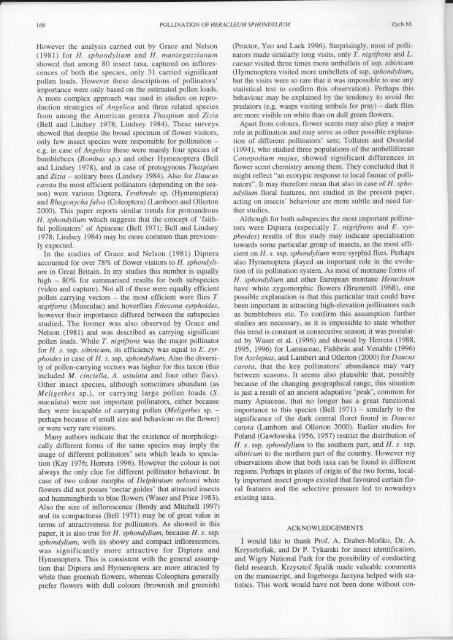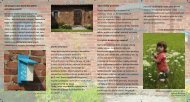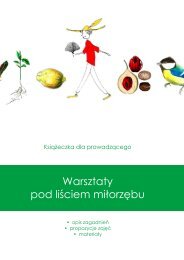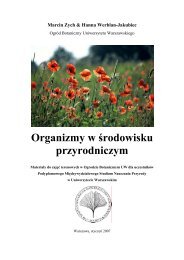POLLINATION BIOLOGY OF HERACLEUM SPHONDYLIUM L ...
POLLINATION BIOLOGY OF HERACLEUM SPHONDYLIUM L ...
POLLINATION BIOLOGY OF HERACLEUM SPHONDYLIUM L ...
You also want an ePaper? Increase the reach of your titles
YUMPU automatically turns print PDFs into web optimized ePapers that Google loves.
l6{t<br />
<strong>POLLINATION</strong> <strong>OF</strong> H ERAC LEU M S P HON DYLIU M<br />
ZychM.<br />
However the analysis carried out by Grace and Nelson<br />
(1981) for H. sphondylium and H. mantegazzianum<br />
showed that among 80 insect taxa, captured on inflorescences<br />
of both the species, only 31 carried significant<br />
pollen loads. However these descriptions of pollinators'<br />
importance were only based on the estimated pollen loads.<br />
A more complex approach was used in studies on reproduction<br />
strategies of Angelica and three related species<br />
from among the American genera Thaspium and Zizia<br />
(Bell and Lindsey 1978; Lindsey 1984). These surveys<br />
showed that despite the broad spectrum of flower visitors,<br />
only few insect species were responsible for pollination -<br />
e.g. in case of Angelica these were mainly four species of<br />
bumblebees (Bombus sp.) and other Hymenoptera (Bell<br />
and Lindsey 1978), and in case of protogynotts Thaspium<br />
and Zizia - solitary bees (Lindsey 1984). Also for Daucus<br />
carota the most efficient pollinators (depending on the season)<br />
were various Diptera, Tenthredo sp. (Hymenoptera)<br />
and Rhagonycha fulva (Coleoptera)(Lambom and Ollerton<br />
2000). This paper reports similar trends for protoandrous<br />
H. sphondyliumwhich suggests that the concept of 'faithful<br />
pollinators' of Apiaceae (Bell 1971; Bell and Lindsey<br />
1978; Lindsey 1984) may be more common than previous-<br />
Iy expected.<br />
In the studies of Grace and Nelson (1981) Diptera<br />
accounted for over 78Vo of flower visitors to H. sphondylium<br />
in Great Britain. In my studies this number is equally<br />
high - 807o for summarised results for both subspecies<br />
(video and capture). Not all of these were equally efficient<br />
pollen carrying vectors - the most efficient were flies T.<br />
nigrifoms (Muscidae) and hoverflies Eiozona syrphoides,<br />
however their importance differed between the subspecies<br />
studied. The former was also observed by Grace and<br />
Nelson (1981) and was described as carrying significant<br />
pollen loads. While I. nigifrons was the major pollinator<br />
for H. s. ssp. sibiicum, its efficiency was equal to E. syrphoides<br />
in case of H. s. ssp. sphondylium. Also the diversity<br />
of pollen-carrying vectors was higher for this taxon (this<br />
included M. cinctella, A. ustulqta and four other flies).<br />
Other insect species, although sometimes abundant (as<br />
Meligethes sp.), or carrying large pollen loads (S.<br />
maculata) were not important pollinators, either because<br />
they were incapable of carrying pollen (Meligethes sp. -<br />
perhaps because of small size and behaviour on the flower)<br />
or were very rare visitors.<br />
Many authors indicate that the existence of morphologically<br />
different forms of the same species may imply the<br />
usage of different pollinators' sets which leads to speciation<br />
(Kay 1976;Henera 1996). However the colour is not<br />
always the only clue for different pollinator behaviour. In<br />
case of two colour morphs of Delphinium nelsonii wh\te<br />
flowers did not posses 'nectar guides'that attracted insects<br />
and hummingbirds to blue flowers (Waser and Price 1983).<br />
Also the size of inflorescence (Brody and Mitchell 1997)<br />
and its compactness (Bell 1971) may be of great value in<br />
terms of attractiveness for pollinators. As showed in this<br />
paper, it is also true for H. sphondylium, because H. s. ssp'<br />
sphondylium, with its showy and compact inflorescences,<br />
was significantly more attractive for Diptera and<br />
Hymenoptera. This is consistent with the general assumption<br />
that Diptera and Hymenoptera are more attracted by<br />
white than greenish flowers, whereas Coleoptera generally<br />
prefer flowers with dull colours (brownish and greenish)<br />
(Proctor, Yeo and Lack 1996). Surprisingly, most of pollinators<br />
made similarly long visits, only I. nigifrons urd L.<br />
caeser visited three times more umbellets of ssp. sibiicum<br />
(Hymenoptera visited more umbellets of ssp. sphondylium,<br />
but the visits were so rare that it was impossible to use any<br />
statistical test to confirm this observation). Perhaps this<br />
behaviour may be explained by the tendency to avoid the<br />
predators (e.g. wasps visiting umbels for pray) - dark flies<br />
are more visible on white than on dull green flowers.<br />
Apart from colours, flower scents may also play a major<br />
role in pollination and may serye as other possible explanation<br />
of different pollinators' sets; Tollsten and Ovstedal<br />
(1994), who studied three populations of the umbelliferean<br />
Conopodium majus, showed significant differences in<br />
flower scent chemistry among them. They concluded that it<br />
might reflect "an ecotypic response to local faunae of pollinators".<br />
It may therefore mean that also in case of H. sphondylium<br />
floral features, not studied in the present paper,<br />
acting on insects' behaviour are more subtle and need further<br />
studies.<br />
Although for both subspecies the most important pollinators<br />
were Diptera (especially T. nigifrons and E. syrphoides)<br />
results of this study may indicate specialisation<br />
towards some particular group of insects, as the most efficient<br />
on F1. s. ssp. sphondylium were syrphid flies. Perhaps<br />
also Hymenoptera played an important role in the evolution<br />
of its pollination system. As most of montane forms of<br />
H. sphondylium and other European montane Heracleum<br />
have white zygomorphic flowers (Brummitt 1968), one<br />
possible explanation is that this particular trait could have<br />
been important in attracting high-elevation pollinators such<br />
as bumblebees etc. To confirm this assumption further<br />
studies are necessary, as it is impossible to state whether<br />
this trend is constant in consecutive season; it was postulated<br />
by Waser et al. (1996) and showed by Henera (1988,<br />
1995, 1996) for Lamiaceae, Fishbein and Venable (1996)<br />
for Asclepias, and Lambert and Ollerton (2000) for Daucus<br />
carota, that the key pollinators' abundance may vary<br />
between seasons. It seems also plausible that, possibly<br />
because of the changing geographical range, this situation<br />
is just a result of an ancient adaptative 'peak', common for<br />
many Apiaceae, that no longer has a great functional<br />
importance to this species (Bell 1971) - similarly to the<br />
significance of the dark central floret found in Daucus<br />
carota (Lunbom and Ollerton 2000). Eartier studies for<br />
Poland (Gawlowska 1956,1957) restrict the distribution of<br />
H. s. ssp. sphondylium to the southem part, and H. s. ssp.<br />
sibiicum to the northem part of the country. However my<br />
observations show that both taxa can be found in different<br />
regions. Perhaps in places of origin of the two forms, locally<br />
important insect groups existed that favoured certain floral<br />
features and the selective pressure led to nowadays<br />
existing taxa.<br />
ACKNOWLEDGEMENTS<br />
I would like to thank Prof. A. Draber-Moriko, Dr. A.<br />
Krzysztofiak, and Dr P. Tykarski for insect identification,<br />
and Wigry National Park for the possibility of conducting<br />
field research. Krzysztof Spalik made valuable comments<br />
on (he manuscript, and Ingeborga Jarzyna helped with statistics.<br />
This work would have not been done without con-





